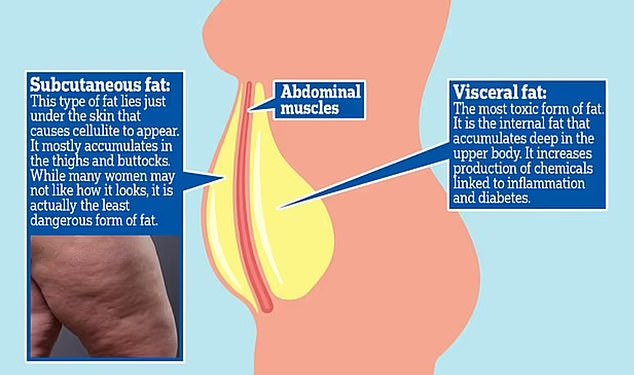You can be obese AND healthy, study suggests – here’s how
People who exercise for years, even those who are still obese, store body fat in a healthier way than people who are inactive.
Researchers at the University of Michigan took two groups of adults with obesity: one group exercised at least four times a week for two years and the other group did not exercise regularly.
Samples of fatty tissue just under the skin of people in both groups showed that those who exercised had more blood vessels in that tissue, implying better oxygen flow through their bodies. The exercisers also had better overall health markers, despite having the same amount of fat as the non-exercisers.
Although the results suggest that people can unlearn a bad diet through exercise, the researchers only looked at subcutaneous fat, the fat that sits just beneath the skin.
This is different from visceral fat, a more dangerous type of fat that builds up around vital organs and leads to inflammation, high blood pressure, heart disease, and in some cases nonalcoholic fatty liver disease.
Two groups of people had similar fat masses, but the group that exercised regularly for years saw better heart health and insulin regulation, leading to better overall health
Dr Jeffrey Hotowitz, an exercise scientist at the University of Michigan, said: ‘Our findings suggest that regular exercise over months to years is not only a way to burn calories, but also to adapt your fat tissue in a way that allows you to store body fat in a healthier way if you do gain some weight – as almost everyone does as we age.’
Dr. Horowitz adds: “In general, we see that these differences are greater in people who have been exercising regularly for years than in people who have not.”
Their research was published in the journal Nature Metabolism.
Using blood tests, MRI scans and laboratory samples of fat tissue, the researchers found that people who exercised regularly had better heart health, despite having the same body fat percentage and weight.
Their bodies also appeared to be better able to regulate insulin levels, potentially preventing diabetes, which is linked to obesity.
Blood tests showed that people who exercise regularly are more likely to have higher levels of ‘good’ HDL cholesterol.
Blood tests also showed that people who exercise regularly have fewer inflammatory markers in the body and better liver function than people who are inactive.
Regular exercise has also been shown to reduce the size of fat cells and increase their ability to store and release energy. It also reduces the amount of visceral fat a person has, reducing the risks of numerous chronic health conditions.
According to the researchers, the subjects had subcutaneous fat, while they did not examine the more dangerous visceral fat.

Researchers specifically studied subcutaneous fat in 32 people – 16 who exercised four times a week for an average of 11 years and 16 who were sedentary
That’s not to say that subcutaneous fat isn’t dangerous. Too much of it can lead to serious health problems, including diabetes, heart disease, high blood pressure, joint pain, sleep apnea and fatty liver disease.
Excess belly fat can also cause fatty tissue to become denser, disrupting the normal function of fat in the body. Fat stores energy for later use, produces hormones, and regulates metabolism.
People who exercise frequently also have less collagen in their bodies, which is most associated with metabolic problems such as type 2 diabetes, obesity, abnormally high blood fat levels, overactive thyroid and non-alcoholic fatty liver disease.
In people with obesity, the size of fat cells also affects the number of blood vessels in the fat tissue that carry oxygen to tissues elsewhere in the body.
Large fat cells often cause fewer blood vessels in the fat tissue, which means less oxygen can flow to the fat tissue. This can lead to inflammation and possibly scarring.
Although the fat cells in both groups were about the same size, the exercisers had more blood vessels in their fat tissue. This suggests that regular exercise improves the ability of fat tissue to absorb oxygen and nutrients.
This is not the first study to show that exercise can promote blood vessel growth. However, scientists are still not sure how many weeks or months of exercise are needed to see a noticeable increase in blood vessels in fat tissue in overweight or obese people.
The UM study offers valuable insights, but can be discouraging for people with obesity who are just starting out in fitness and want faster results.
